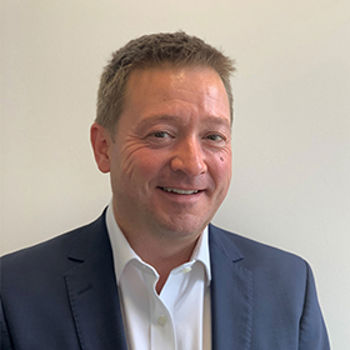Tell us about your background and experience
I qualified as a pharmacist 26 years ago and started my career in community pharmacy, working as a relief pharmacist – it was straight in at the deep end!
I then took the leap into hospital pharmacy and worked as a dispensary manager in a small hospital. I spent a lot of time working with the mental health teams, attending ward rounds and holding pharmacist drop-in clinics for the service users. It was here I first became interested in mental health, the treatments available, and the frustrations experienced by patients and their families.
I’ve also worked as a palliative care pharmacist and I was the advisory pharmacist for two hospices, working alongside the doctors and nurses, and spending time with patients and their relatives discussing medication.
I then had quite a change and went to work for the Primary Care Trust (as it was then) as a practice pharmacist covering eight GP practices, where I was tasked with improving prescribing practice, cost savings and also the dreaded hospital discharges. I went back to university and qualified as an independent prescriber so I could hold chronic disease management clinics.
I had been reluctant to leave clinical work, but found that I enjoyed healthcare IT following my first non-clinical role as a Product Specialist at a software company for their Electronic Prescribing and Medicines Administration (ePMA) module. I developed my experience in IT further as I progressed to a new role as a Product Manager in a different company.
I started work at Advanced in July this year as the ePMA Implementation Lead and have immersed myself in the world of Carenotes ePMA. I still sign onto the pharmaceutical register so I have to prove that I am constantly learning as a pharmacist, and evaluating and improving my knowledge.
What are the key challenges affecting the way medicines are prescribed and dispensed today?
Primary care and secondary care are still poles apart in the way medication is prescribed.
Within primary care, prescriptions are mostly sent to pharmacies electronically, whereas in secondary care much prescribing is still done on paper drug charts. The paper charts are often not by the patient’s bedside and can be damaged and illegible. There are more and more medications on the market now, and guidelines are very specific in the recommended medication regimes for treating conditions, so often patients will be taking at least five medications, and sometimes more than 20, which poses a challenge with interactions and allergies.
The NHS spends over £16 billion a year now on drugs and there is a huge drive to reduce this, eliminate waste and increase prescribing efficiency so that patients receive the right pharmaceutical treatment for their conditions.
How can an e-prescribing solution benefit prescribers, dispensers and the wider public receiving healthcare?
Using an electronic prescribing system instead of a paper one means that the patient’s drug chart is always available, both by the bedside and remotely, so there is no delay if a patient needs a change to a medication, or needs a drug administration urgently. The medication is always legible and there is no wasted time for prescribers rewriting the paper drug charts every 14 days. Prescribing habits can be governed and monitored by the use of hospital formularies and a reporting system, leading to more efficient and appropriate prescribing - and potential cost savings.
Antibiotic use is a perfect example; a patient’s treatment can be more closely monitored using ePMA, because there must be justification for prescribing. Antibiotics delivered through the intravenous route can also be monitored, in an attempt to reduce antimicrobial resistance.
The decision support provided with an ePMA solution will highlight allergies to prescribed medication, interactions and duplications, which all reduce potential risks to the patient. With an interface between an ePMA system and the Trust Pharmacy module, there will be a reduction in transcribing errors and discharge medication can be ordered more efficiently.
What is already being done within the NHS today to implement e-prescribing?
Only about a third of NHS Trusts have already implemented an ePMA system into some inpatient wards and departments. There are still challenges with receipt of medication information at the point of transfer of care, particularly on admission and at discharge, and new standards have been set by NHS Digital for discharge summaries to improve the way GPs receive the information from secondary care. Mental health trusts pose challenges for ePMA due to regular patient movement between hospital and into the community, where they still receive inpatient care, but in their own home.
In your role at Advanced, how do you bring your experience to our software solutions?
I bring experience from the clinical and practical aspects of pharmacy and prescribing practice, as well as five years’ experience of implementing ePMA systems into both acute and mental health trusts. This means that I can work with the customers and the teams at Advanced to get the best out of the software, and facilitate a smooth implementation. My pharmacist training means that I am very thorough and meticulous, so I am also very handy for evaluating software and reviewing documentation.
What does the future of prescribing look like?
Genomics is really starting to make an impression – we will be able to offer patients individualised drug treatment using their genome (a person’s complete set of DNA and genes) to predict disease response. It will give us improved knowledge into the prediction and prevention of disease. This will mean, more than ever, our computer systems will need to interface and data will need to be shared. Currently NHS England are running the 100,000 Genomes Project which is studying patients with rare diseases, and their families, and also patients with common cancers, in order to sequence 100,000 genomes and gather a substantial amount of information.
We also need to educate patients so that they can play their part in creating a more efficient healthcare system, and the onus is not on ‘a pill for all ills’. There is a huge drive in the NHS and Public Health England to provide health information and promote healthy living to patients, and there are mobile apps available to provide education and capture data, in an attempt to reduce the costs to the NHS and help people live longer, healthier lives.



